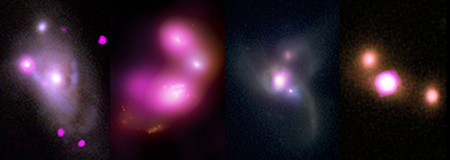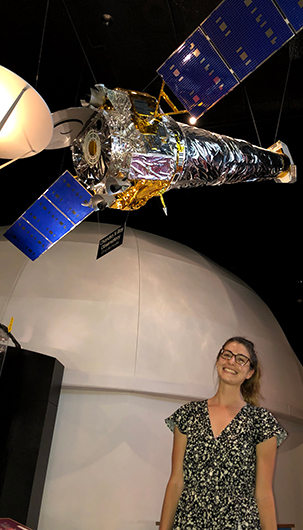Three's a Crowd: Triple Galaxy Collisions and Their Impact on Black Hole Accretion

Adi Foord
We are pleased to welcome Adi Foord as a guest blogger. Adi is the first author of a pair of papers that are the subject of the latest Chandra press release. She is a Post postdoctoral fellow at the Kavli Institute of Particle Astrophysics and Cosmology at Stanford University. She received her bachelor's degree in Physics & Astronomy from Boston University in 2014, and recently received her Ph.D. in Astronomy & Astrophysics from the University of Michigan (Summer 2020). Adi is a high-energy astrophysicist who is interested in how and which environmental properties impact supermassive black hole accretion and evolution. Most of her work uses X-ray observations of supermassive black holes, and she is currently focusing on systems where two supermassive black holes are in the process of merging.
With the advancement of gravitational wave detectors such as LIGO, we are starting to get real proof that black holes exist, and that some evolve over time via mergers with other black holes. The black holes that gravitational wave detectors like LIGO study are solar mass black holes. As the name and unit imply, these black holes have masses between about five and 100 times that of the sun, and are believed to be formed after the death of a massive star. But what about supermassive black holes, the massive counterparts to solar mass black holes that lie at the center of most massive galaxies? With the groundbreaking image supplied by the Event Horizon Telescope (EHT) in April 2019, we were given proof that supermassive black holes exist as well. But in order to have proof that they merge, and emit gravitational waves, we will have to wait for results from pulsar timing arrays (PTAs) and space-based interferometry (such as LISA). This is because the expected gravitational wave frequencies the supermassive black hole mergers are theorized to emit are outside the range of LIGO.
Thus, some of the strongest proof that supermassive black holes are on a collision course to merge comes from observational analyses using telescopes that detect electromagnetic radiation, such as NASA’s Chandra X-ray Observatory with its X-ray vision. Chandra's peers through dust and gas to detect some of the hottest material swirling around supermassive black holes that are actively accreting (that is, drawing material toward them). In other words, Chandra is one of the most powerful tools for finding supermassive black holes. Most of my work uses Chandra observations of accreting supermassive black holes, which due to their placement in the center of galaxies are called active galactic nuclei, or AGN. Interacting systems of AGN, usually associated with pairs of galaxies that are merging, are called "dual AGN". I try to find dual AGN in Chandra observations, and then use complementary optical or infrared observations to learn more about their host galaxies.
There are many questions that remain regarding how dual AGN evolve over time, and why some galaxies have very active supermassive black holes while others have galactic centers that are completed devoid of X-ray emission (and thus their supermassive blacks are classified as "quiescent"). Furthermore, some studies have shown that two supermassive black holes that are in the process of merging will likely face many hurdles in order to eventually merge. For one, there needs to be ample amounts of inflowing gas, at all stages of the merger, for the supermassive black holes to continue moving toward one-another. On top of this, even systems with large reservoirs of available gas may take a long time to merge. This latter point has been coined the "nightmare scenario," where the time for two supermassive black holes is longer than the age of the Universe, and thus their expected gravitational wave signal will never be detected by PTAs.
However, interactions with a third supermassive black hole can help alleviate these issues. The presence of a third supermassive black hole, in a separate galaxy, can disturb the stellar orbits of the merging galaxies, supplying more gas to central regions, and allowing the two supermassive black holes to continue moving toward one another. More importantly, the presence of a third supermassive black hole can help shrink the separation between the two merging black holes, which can dramatically reduce the merger time of supermassive black holes. Excitingly, simulations show that triple AGN are expected to be relatively common. But to date, there has yet to be a systematic study of X-ray triple AGN in our observable Universe and only one X-ray triple AGN has been detected to date. Where are all the triple AGN hiding?
This motivated me to create and analyze a sample of nearby triple galaxy mergers to find more triple AGN systems. There was more to the project, however, as we expected to find a range of AGN activity. We thought it was likely that some systems would have no AGN, while others would have one, two or three. The bigger point of this analysis was to measure if the number of actively accreting supermassive black holes depended on any environmental properties of the merger — such as gas and dust levels. What is different about the environment of a triple galaxy merger that has three actively accreting supermassive black holes, versus one that has only one actively accreting supermassive black hole?

Four of the triple galaxy mergers in the survey. Left to right: NGC 3341, J1027, J0849 & J1708.
Our sample was composed of seven triple galaxy mergers that were all visually identified by sifting through available optical observations taken with the Sloan Digital Sky Survey, an optical light telescope in New Mexico. Each system also had publicly available Chandra data to analyze. I analyzed each Chandra observation using a tool I developed as a graduate student at the University of Michigan. The tool is called BAYMAX (Bayesian AnalYsis of Multiple AGNs in X-rays), which shares a name with a friendly robot from the Marvel Universe (and has an appropriately cool logo). BAYMAX is a statistical tool that was developed to find dual AGN in Chandra datasets. It's especially powerful for low-luminosity and closely separated dual AGN that may not be obvious by eye. Using BAYMAX, I confirmed previous work that one of the seven triple galaxy mergers was composed of three AGN, four of the seven likely contain two AGN, and one has a single AGN. The last system had no X-ray evidence of any accreting supermassive black holes.

Adi Foord standing beneath a model
of the Chandra X-ray Observatory
Perhaps the most interesting result from this analysis was discovered by pairing the X-ray results with infrared observations of each merger. Infrared observations are very sensitive to dust levels so we can use them to measure of how dusty a galaxy is. On the other hand, X-ray observations can provide evidence on how much gas is immediately surrounding a supermassive black hole. For environments with large levels of nuclear gas, a significant fraction of the X-rays will be obscured. The levels of nuclear gas can be estimated when analyzing the X-ray data. For the triple galaxy mergers in our sample, we found that higher levels of large-scale dust (provided by infrared observations) coincided with higher levels of nuclear gas and dust (provided by X-ray observations).
This supports the idea that during triple galaxy merger events, large amounts of gas and dust can be efficiently funneled into the nuclear regions, where the supermassive black holes can easily accrete it. On top of this, the one triple AGN system has the largest levels of gas and dust, compared to the other systems that were found to have one or two AGN. This result suggests that as gas and dust levels increase, the number of supermassive black holes that "turn on" (or, are actively accreting, and are thus "AGN") will increase. We hope in the future to carry out more of these studies with much larger samples of triple galaxy mergers. By doing so, we may find even more triple AGN, giving us a better understanding of the observationally rare, but theoretically significant, systems that may be the catalysts behind supermassive black hole mergers.
Category:
- Log in to post comments
